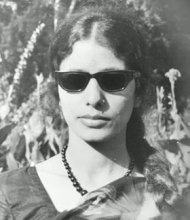
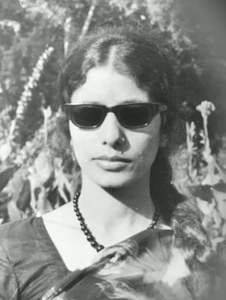 (Tribute) Uterus by Deepak Shimkhada, Ph.D.
(Tribute) Uterus by Deepak Shimkhada, Ph.D.
[This tribute was previously published in She Rises: What… Goddess Feminism, Activism and Spirituality? Volume 3, (Mago Books, 2019), pages 287-93.]
What differentiates male and female? It’s a simple but important question. And the answer is the uterus.
The woman has a uterus, but the man does not. Without this organ, there could be no living beings – not today, nor since the beginning of time. And these beings will continue to reproduce until the planet that sustains them comes to an end through cataclysm.
The question is, then, does the uterus give the female more power than the male? I should think so; because the uterus is obviously an important organ that alone brings life to earth. No matter how hard he tries, a male cannot grow a fetus in his body.
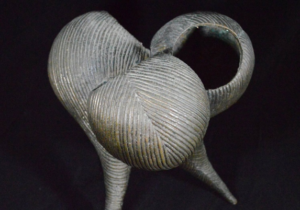
Medical science has successfully grown bacteria in a petri dish. Accordingly, a human fetus can theoretically be grown outside of a female uterus. To do so, scientists will have to replicate the ideal biological reproductive conditions and environment that allows a fetus to grow. But would that individual –biologically detached from its mother– be a normal human being? Would it be a new ‘breed’ of humans that behaves more like a robot than a human being? Until such time comes, the female is in the driver’s seat, taking control of the reproductive function.
Hence, because of the important role a woman plays in reproduction and nurturing, she is elevated to the position of all-powerful Goddess. When we examine a plethora of texts, legends, and folklore associated with her, we can clearly see that this is the case in Hinduism. But what about other cultures? Do they recognize the importance of the uterus and valorize woman by elevating her to the position of Goddess?
The article below, written for a conference and presented at an art-history panel, examines one of Sushma Shimkhada’s important works dealing with the symbolism of uterus.
Nepali artist Sushma Shimkhada was a feminist, a radical, and a rebel who was way ahead of her time. She began her career in the early 1970s, and her journey wasn’t an easy one. In Nepal, the profession of sculpture belonged traditionally to males – and as one of the first female sculptors, she constantly combatted this. She finally carved a niche and established herself as a formidable artist, earning several recognitions and awards. Her works were exhibited, acquired, and sold both domestically and internationally. Unfortunately, the honeymoon didn’t last long. Her flourishing career came to a sudden halt in the mid-1980s, when she was afflicted by debilitating osteoarthritis.
Here, I will take just one piece that speaks her mind when it comes to the subject of women and their role in society. Why she focused on women is a journey of sorts, which will take us back in time and space to delve into her life and philosophy of the womb she embraced as she was emerging as a sculptor.
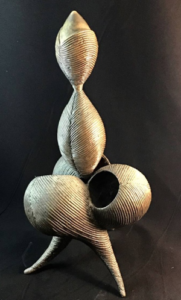 When asked about this work, Sushma told me, “A womb is our home, our universe. We were all created in the womb and we return to it.” In this presentation, I will mainly focus on this piece that depicts the idea of the womb, and I will analyze her works in the context of Hindu feminism.
When asked about this work, Sushma told me, “A womb is our home, our universe. We were all created in the womb and we return to it.” In this presentation, I will mainly focus on this piece that depicts the idea of the womb, and I will analyze her works in the context of Hindu feminism.
In Sushma’s view, three wombs equal Tri-Loka. Tri Lokas, in Hindu cosmology, are representative of our solar system; they combine our physical world, intermediate space with atmosphere, and deep space without atmosphere. In traditional religious texts like the Puranas and the epics, the third world is also known as Patala. It’s the underworld or nether world, and it’s imaginary, rather than physical.
The womb represents creative feminine energy – a place where life can be created and nurtured. Hence, it’s a sacred space. Men who kick a woman’s womb with their feet show utter disrespect, denying its sanctity and functionality.
As the sacred space in which life begins to formulate, a womb takes on the role of many positive things in life. The rounded shape of the womb resembles the planet Earth, home to many billions of life forms. A rounded womb also resembles a pot (Kumbha), which is a receptacle for fluid. As we know, fluid is required to sustain life, and it must be preserved and honored for what it is, if life is to continue on this planet. To prove her point, Sushma used to note that a flat object cannot hold water.
Why three wombs? According to Sushma, three is a complete number because it represents past, present, and future – a totality of time. As long as there is creation, the womb will remain. Without it, there can be no creation. The ocean is a gigantic womb where early life formed, and it’s still home to a myriad of marine creatures, both large and small. Water is, therefore, the amniotic fluid that engenders life of all forms, from the tiniest to the largest. In Sushma’s view, a womb that folds life-sustaining fluid is our mother.
This may be the reason that Sushma was a great devotee of the Goddess Kali, who stood for both creation and destruction. From that standpoint, the womb can be seen both as a cradle and a grave, to which we all return after death. Anything that is born must die; this is the law of nature. Western scholars have recently recognized the womb’s powerful dual functions. However, Hindu theologians recognized the dual functions of Kali thousands of years before.
Sushma’s love for children is noteworthy. Since children emerge from the womb – the place they call home during gestation – Sushma believed that they served as a bridge between the womb and their mothers. Sushma admired the purity and innocence found in children, and in them saw the image of the Divine. She would often call children “Little Gods and Little Goddesses,” and her love for them manifested in her works. Many of her earlier works were of children playing alone or with their mothers, depicting a dimension of her real life.
 Sushma was a spinster. Although she had a womb, she could not use it to give birth. She acknowledged her limitations but took delight in the children of her extended family members. She treated her nieces and nephews as though they were her own, always playing with them and creating fond memories. This may be seen as a way of fulfilling one’s inadequacy of motherhood through other women’s children. In this figure, she pours out her sensitivity to capture the innocence of a child.
Sushma was a spinster. Although she had a womb, she could not use it to give birth. She acknowledged her limitations but took delight in the children of her extended family members. She treated her nieces and nephews as though they were her own, always playing with them and creating fond memories. This may be seen as a way of fulfilling one’s inadequacy of motherhood through other women’s children. In this figure, she pours out her sensitivity to capture the innocence of a child.
When she was barely 14 years old, Sushma was given away in marriage to a man from a distant village. He was 25 or 26 years old. As was customary of the Hindu tradition of the time, she returned to her parental home after spending three months at her husband’s home. We have no idea what happened to her in the hands of her husband or his parents, but she decided not to return to him. Her parents honored her wish and took her back as one of their male children, giving her equal claim to the parental property.
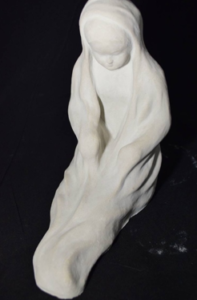 A peek into her personal life may shed some light on the thought process behind her works. Whether it was a trauma or something else, the things that she experienced in her husband’s home seem to have shaped her life as a feminist. Her deep conviction in the power of the goddess Kali led her to meditate on and worship Kali. She reported having visions of the goddess and spent days and nights in the Kali temple of Subha-Bhagavati. She admitted to gaining Shakti by the blessings of Kali, who appeared in her visions while meditating. After her brother passed away, she lived alone in Kathmandu.
A peek into her personal life may shed some light on the thought process behind her works. Whether it was a trauma or something else, the things that she experienced in her husband’s home seem to have shaped her life as a feminist. Her deep conviction in the power of the goddess Kali led her to meditate on and worship Kali. She reported having visions of the goddess and spent days and nights in the Kali temple of Subha-Bhagavati. She admitted to gaining Shakti by the blessings of Kali, who appeared in her visions while meditating. After her brother passed away, she lived alone in Kathmandu.
When the 7.8 magnitude earthquake shook Nepal in 2015, everyone fled to open spaces, seeking protection from collapsing homes. Sushma, however, did not leave her apartment. She was unable to walk as a result of her foot surgery, which was performed just a few weeks prior to the devastating earthquake. According to her, the Shakti she gained through meditation allowed her to go through life, especially during this natural disaster.
Linga is defined as a pillar, an object with a sharp pointed head, a phallus, or an axis mundi. Its nature is to penetrate with the ability to go deep. Whether it causes pain, pleasure, or even achieves the desired result depends on the intent. For example, a drill is used to bore through Earth to bring forth water. It’s an act that benefits living creatures. But it may also be used for a nefarious purpose – with the intent to cause pain or harm. Similarly, a phallus can be used in the same way. When used as an object of domination, such as in the case of rape, it causes pain and suffering. The reverse is true in the case of love, leading to procreation.
While I don’t know Sushma’s view on this subject, I’ve examined her body of work and know the stance she took against age-old, male-dominated traditions. From this, it can be inferred that she intended to rebel against the patriarchy symbolized by linga. As a devotee of Kali, she used to say that goddess Kali was superior to all male gods. But a balanced relationship between the male and the female –Purusha and Prakriti, symbolized in art by Linga and Yoni – is necessary for a successful life. When that balance is broken, discord takes place.
Boring into Earth to extract crude oil or minerals causes harm to the Earth. For Sushma, Earth is the Mother – she referred to this in many of our conversations. Corporations and people in power cause damage and destruction to the Earth, women, the poor, the sick, and the weak. In Sushma’s eyes, this is true violence – someone or something on top, suppressing all that is below. She spoke against oppression of any kind through art. Most of her works are, therefore, inspired by her convictions against dominant culture, society, government, and even patriarchy. In that sense, she was a rebel who, through her art, fought against these menacing forces.
In this piece, Sushma deliberately conflates the idea of balance and harmony with the images of linga and womb. However, in the image under examination there are three wombs and a single linga, which is squeezed in the middle. The linga is completely under the control of the wombs – the female energy. Although the existence of a male principle is necessary for the continuation of life, its dominant position is checked by the female principle, demonstrating the superiority of the womb – the mother principle.
[Sushma Shimkhada was my sister, and she passed away on February 5, 2018. This is but a small tribute to her from her brother, who could not be with her at the time of her passing. Her legacy and memory will remain with me for the rest of my life. Her short biography can be found in “Sushma Shimkhada,” Wikipedia.]








